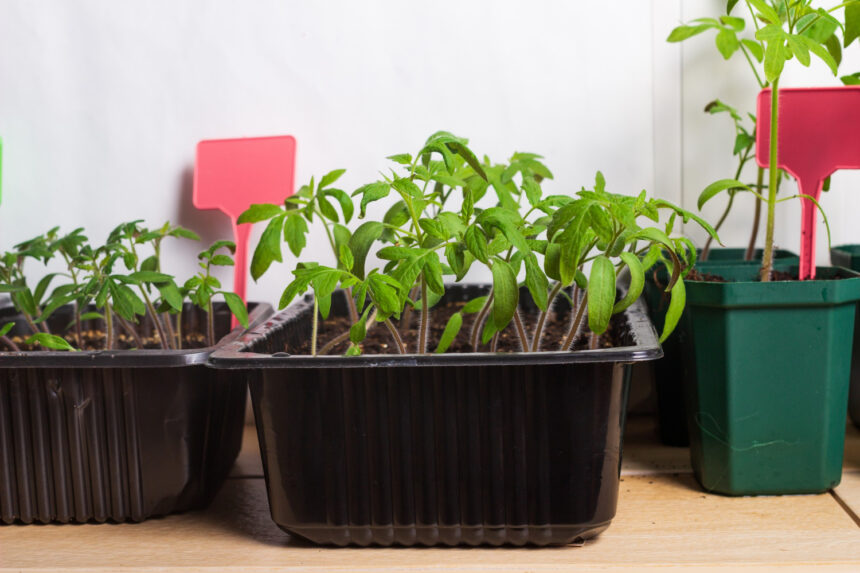Plastic pots offer a practical and affordable solution for planting needs. These lightweight containers come in various sizes and styles, making them suitable for both indoor and outdoor gardening. Choosing the right plastic pot can enhance plant growth and manage drainage effectively.
Many gardeners appreciate plastic pots for their durability and versatility. They are easy to handle and can withstand various weather conditions, which is essential for outdoor use. Furthermore, options such as pots with drainage holes help prevent overwatering, ensuring plants thrive.
With numerous choices available—from traditional flower pots to specialized nursery pots—finding the perfect plastic container to meet specific needs is simple. As gardening continues to grow in popularity, understanding the benefits and features of plastic pots can help gardeners make informed decisions.
Types of Plastic Pots
Plastic pots are widely used for various types of gardening. They come in different shapes, sizes, and styles. Understanding the types of plastic pots can help gardeners choose the right one for their plants.
Nursery Pots
Nursery pots are typically used for starting plants. They are designed for young plants and seedlings that need time to grow.
These pots are usually lightweight and made from durable plastic, which helps them withstand handling.
They often have drainage holes at the bottom to allow excess water to escape. This is important for preventing root rot, which can happen if plants sit in water for too long.
Nursery pots come in various sizes, from small 2-inch pots to larger ones, making them versatile for different plants.
Decorative Pots
Decorative pots are used to enhance the aesthetics of indoor and outdoor spaces. They are available in a wide range of designs, colors, and patterns.
These pots can complement home decor and can be used for showing off houseplants or flowers.
While they may be made from plastic, decorative pots often have a stylish finish that mimics ceramic or stone.
Some decorative pots also have features like built-in drainage systems, which help maintain healthy plant growth.
Choosing the right decorative pot can add beauty while still fulfilling the plant’s needs.
Self-Watering Pots
Self-watering pots offer a convenient solution for busy gardeners. These pots have a built-in reservoir that allows plants to absorb water as needed.
The design includes a water reservoir at the bottom, connected to a soil wicking system. This helps ensure that the soil stays moist without overwatering.
They are ideal for plants that prefer consistent moisture levels or for those who may forget to water regularly.
Self-watering pots come in many styles, so they can fit well into any garden layout. With proper use, they can promote healthier plant growth and reduce watering frequency.
Advantages of Plastic Pots
Plastic pots offer several practical benefits that make them popular among gardeners. Their lightweight nature, durability, and cost-effectiveness are key advantages. Additionally, they come in various designs, providing options for different gardening styles and settings.
Lightweight and Durable
Plastic pots are significantly lighter than pots made from other materials, such as ceramic or terracotta. This makes them easy to lift and move around, which is especially beneficial for gardeners with physical limitations or those who frequently rearrange their plants.
Moreover, plastic pots have excellent durability. Unlike terracotta pots, which can break easily, plastic is more resistant to cracking. This resilience allows plastic pots to withstand various weather conditions, making them ideal for outdoor use.
Cost-Effective
Another major advantage of plastic pots is their affordability. They are generally cheaper than both clay and ceramic pots. This cost-effectiveness allows gardeners to purchase multiple pots without exceeding their budget.
Additionally, their long-lasting nature means that gardeners can make a wise investment. Since plastic pots do not break easily, they can be reused for many planting seasons, providing further savings over time.
Versatility in Design
Plastic pots are available in a wide range of designs, sizes, and colors. This variety makes it easy for gardeners to choose pots that fit their personal style or home decor.
They can also be found with various features, such as drainage holes and self-watering options, enhancing their functionality. Such versatility allows gardeners to select pots that best suit the specific needs of their plants, increasing the chances of successful growth.
Environmental Considerations
Plastic pots play a significant role in the horticulture industry, but they also pose environmental challenges. Understanding recycling methods and exploring biodegradable alternatives can help address these issues.
Recycling and Sustainability
Many plastic pots are not recyclable, which contributes to landfill waste. Most are made from petroleum-based materials, typically classified as #1 and #2 plastics. Some recycling programs accept them, but availability varies.
Recycling initiatives in the green industry have emerged, with organizations working to collect and repurpose pots. Programs exist that allow nurseries to return used pots for recycling. This can reduce waste and promote sustainability.
Here are some key points regarding recycling:
- Collection Programs: Many communities offer collection sites for used pots.
- Repurposing: Some companies transform used pots into new products.
- Limitations: Not all areas have efficient recycling systems for plastic pots.
Biodegradable Options
Biodegradable pots are made from natural materials like bamboo, coconut coir, or compostable plastics. These options break down more easily in the environment, thus reducing landfill impact. They often provide better plant insulation than traditional plastic pots.
Using biodegradable pots can enhance soil quality as they decompose, adding nutrients back into the earth. They are particularly beneficial for gardeners and nurseries looking to improve sustainability.
Consider these points for biodegradable options:
- Materials: Look for pots made from renewable sources.
- Environmental Impact: They decompose over months, compared to decades for plastic.
- Costs: Biodegradable pots may be more expensive but can benefit the environment.
Choosing sustainable practices in the use of plant pots can support a healthier ecosystem.
Care and Maintenance
Proper care and maintenance of plastic pots ensures healthy plants and longevity of the containers. Key practices include effective cleaning procedures and avoiding over-watering to prevent issues like root rot.
Cleaning Procedures
Cleaning plastic pots is essential to remove dirt and potential pests. Begin by emptying the pot completely, ensuring all soil is discarded.
Next, use a stiff brush to scrub the interior. This helps eliminate stuck debris. A mixture of water and a small amount of bleach can disinfect the pots effectively.
Soak the pots in a solution of 10 parts water to 1 part bleach for about 10 minutes to 1 hour. For those preferring alternatives, vinegar can replace bleach. It requires a longer soak, typically a few hours.
Always wear gloves and eye protection while handling bleach. Rinse the pots thoroughly with water after soaking to avoid chemical residue.
Avoiding Over-Watering
Over-watering is a common mistake that can harm plants. To maintain the right moisture level, it’s important to understand the watering needs of each plant.
Water the soil directly to ensure that the roots soak up moisture. A good practice is to check the top inch of the soil for dryness before adding water.
Using pots with proper drainage holes is crucial. Plastic pots typically need a minimum hole size of 1/2 inch in diameter for adequate drainage.
Containers without proper drainage can lead to water pooling, causing root rot. Monitoring moisture levels will help keep plants healthy and thriving in their plastic pots.




